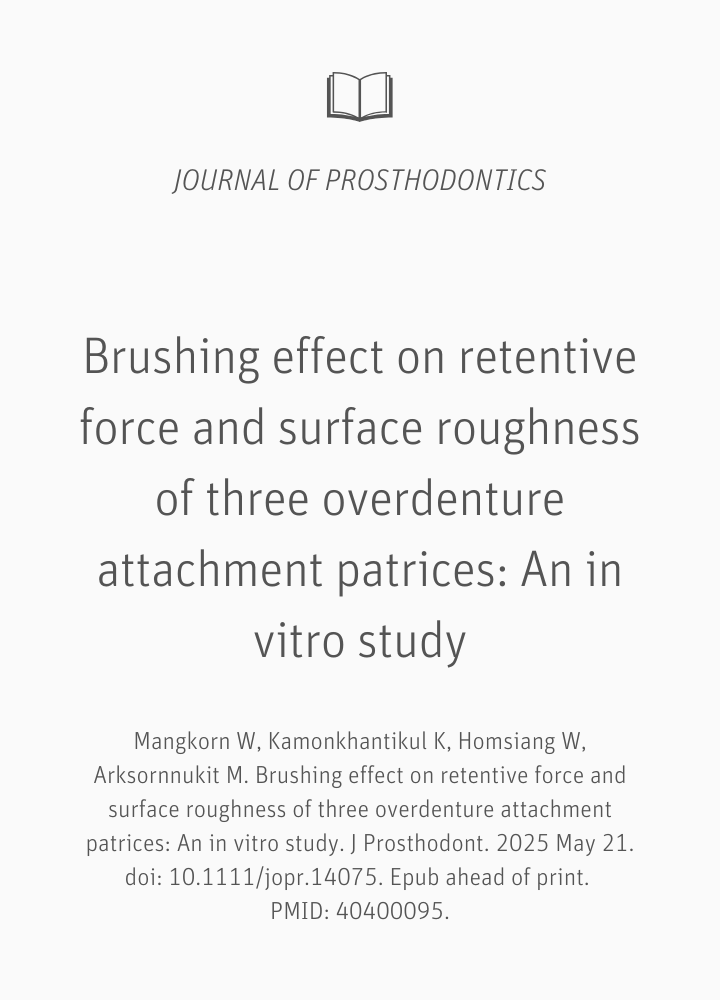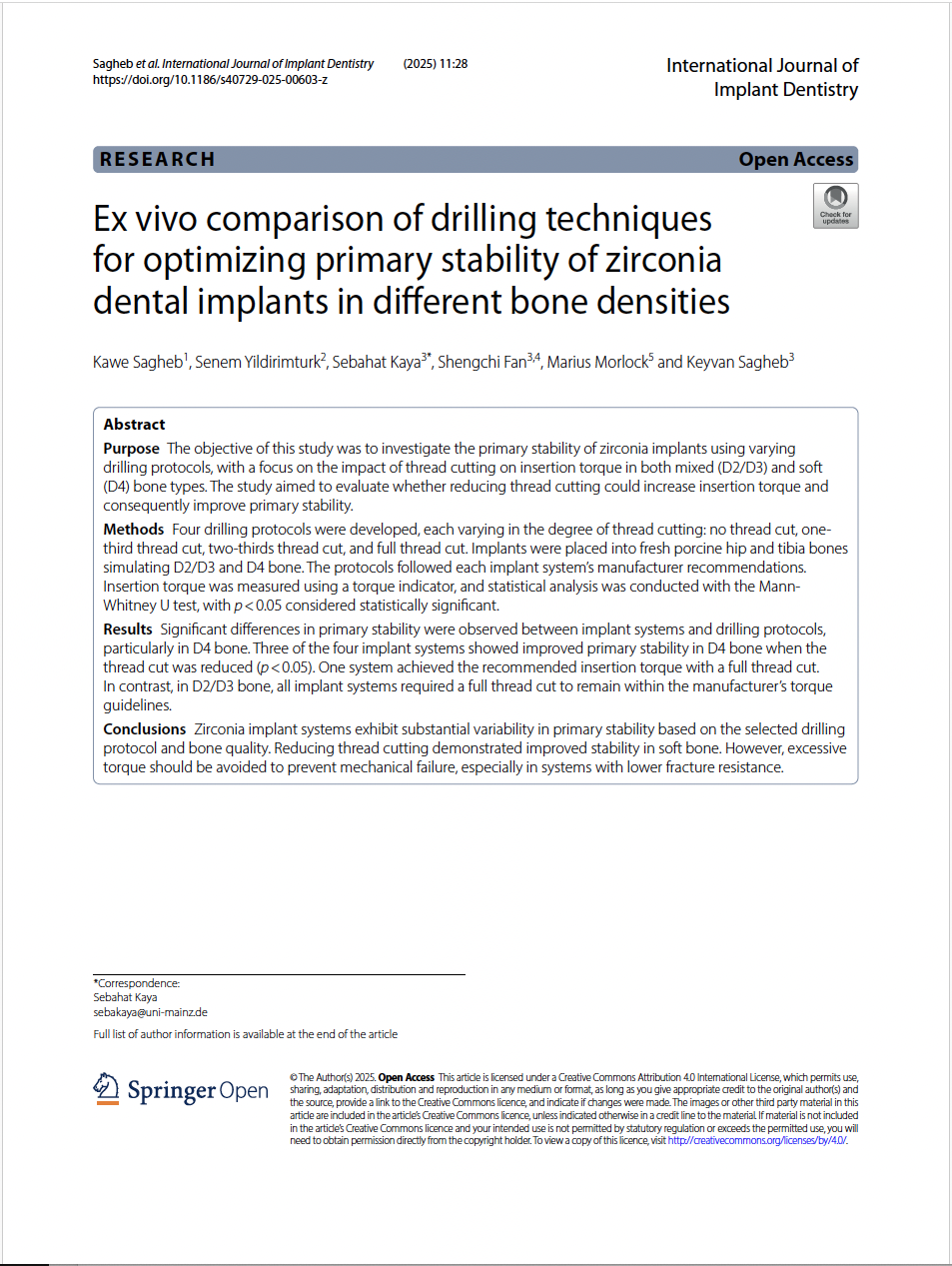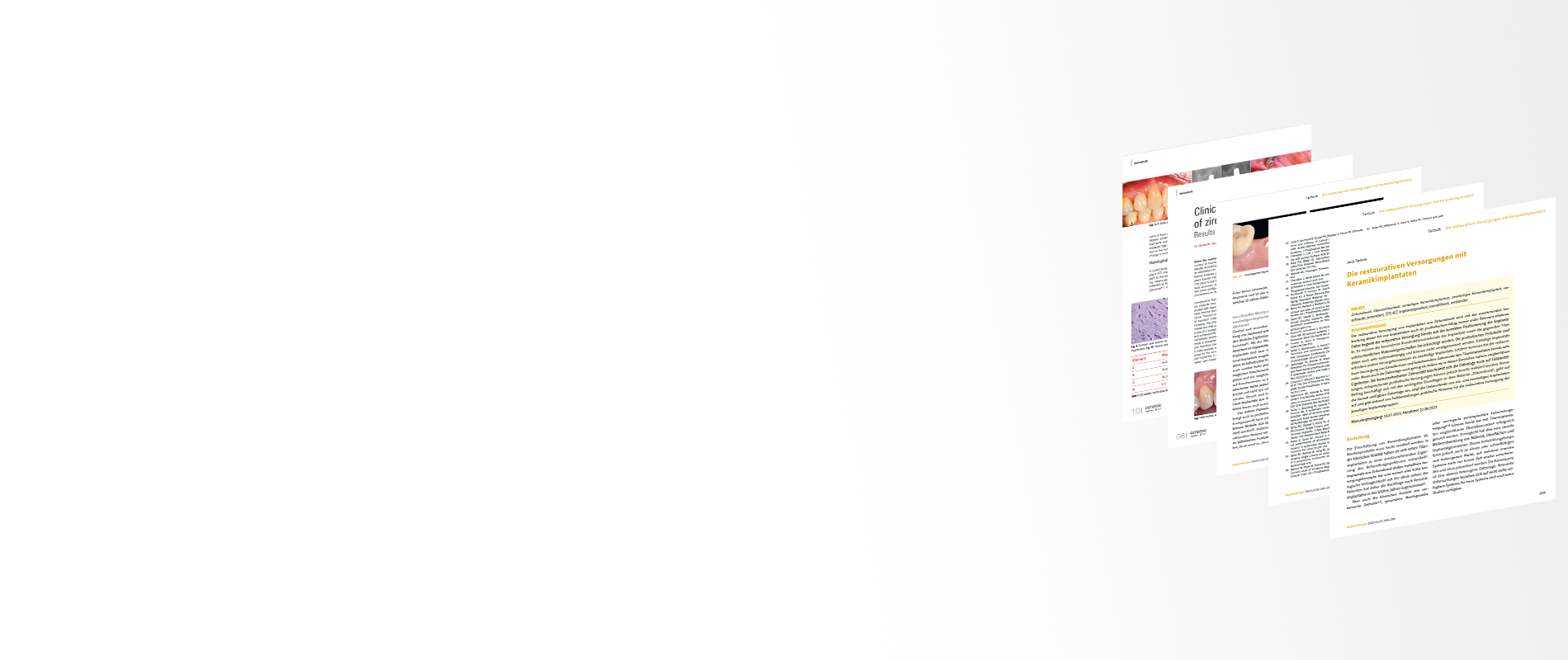Studies & papers
2025
Brushing effect on retentive force and surface roughness of three overdenture attachment patrices: An in vitro study

Mangkorn W, Kamonkhantikul K, Homsiang W, Arksornnukit M. Brushing effect on retentive force and surface roughness of three overdenture attachment patrices: An in vitro study. J Prosthodont. 2025 May 21. doi: 10.1111/jopr.14075. Epub ahead of print. PMID: 40400095.
The purpose of the study was to investigate the brushing effect on retentive force and surface roughness of titanium, coated titanium, and zirconia patrices in several implant-retained overdenture attachments, including Zeramex Docklocs® attachment system.
Conclusion: The patrices in the denture attachment system Zeramex Docklocs® could provide retention and maintain surface characteristics after stimulated brushing for up to 150,000 cycles, which is equivalent to approximately 15 years of clinical use.
Ex vivo comparison of drilling techniques for optimizing primary stability of zirconia dental implants in different bone densities.

Sagheb, K., Yildirimturk, S., Kaya, S. et al. Ex vivo comparison of drilling techniques for optimizing primary stability of zirconia dental implants in different bone densities. Int J Implant Dent 11, 28 (2025). https://doi.org/10.1186/s40729-025-00603-z
The aim of the study by Sagheb et al. (2025) was to investigate the primary stability of zirconia implants using different drilling protocols, focussing on the effects of thread cut on insertion torque in both mixed (D2/D3) and soft (D4) bone types.
Conclusion: Within the limitations of this study, the authors concluded that reducing the thread cut enhances primary stability, as indicated by insertion torque. Reducing thread cutting demonstrated improved stability of Zeramex XT in soft bone D4. In contrast, in D2/D3 bone, Zeramex XT required a full thread cut to remain within the manufacturer’s torque range of 20–45 Ncm.
2023
Fracture Resistance of a Two-Piece Zirconia Implant System after Artificial Loading and/or Hydrothermal Aging-An In Vitro Investigation.

Kohal RJ, Schikofski T, Adolfsson E, Vach K, Patzelt SBM, Nold J, Wemken G. Fracture Resistance of a Two-Piece Zirconia Implant System after Artificial Loading and/or Hydrothermal Aging-An In Vitro Investigation. J Funct Biomater. 2023 Dec 15;14(12):567. doi: 10.3390/jfb14120567. PMID: 38132821; PMCID: PMC10743638.
The aim of this study was to investigate the fracture resistance of the two-piece Zeramex XT implant system. For this purpose, 32 implants with screw-retained zirconia abutments were divided into four groups of eight samples each. Group 0 (control group) was neither loaded nor aged in a chewing simulator; group H was hydrothermally aged; group L was loaded with 98 N; and group HL was subjected to both hydrothermal ageing and loading in a chewing simulator. One sample from each group was analysed for t-m phase transformation, the others were loaded until fracture. A one-way ANOVA was performed to assess the differences between the groups.
No implant fracture occurred during the simulation of artificial mastication. Furthermore, there were no statistically significant differences (p > 0.05) between the groups in terms of fracture strength (group 0: 783 ± 43 N; group H: 742 ± 43 N; group L: 757 ± 86 N; group HL: 740 ± 43 N) and bending moment (group 0: 433 ± 26 Ncm; group H: 413 ± 23 Ncm; group L: 422 ± 49 Ncm; group HL: 408 ± 27 Ncm).
In the context of the present study, it can be concluded that the artificial load and hydrothermal ageing do not reduce the fracture strength of the Zeramex XT implant system investigated.
Clinical outcomes of zirconia implants: a systematic review and meta-analysis

Mohseni P, Soufi A, Chrcanovic BR. Clinical outcomes of zirconia implants: a systematic review and meta-analysis. Clin Oral Investig. 2023 Dec 23;28(1):15. doi: 10.1007/s00784-023-05401-8. PMID: 38135804; PMCID: PMC10746607.
The meta-analysis included 25 studies that provided information on the failure rate of implants in any group of patients with zirconia implants.
The studies reported on 4017 zirconia implants (including 49 Zeramex T implants) in 2083 patients. The patients were 851 (42.4%) men and 1,157 (57.6%) women, with no gender information available for 75 patients. Patients received an average of 1.91 ± 1.51 (range: 1-14) implants. 7 of 25 studies had a follow-up period of more than 60 months.
The cumulative 10-year survival rate of zirconia implants is 95.1 %. The mean MBL fluctuated between 0.632 and 2.060 mm over long observation periods (up to 132 months).
2022
Spectrometric Analysis of the Wear from Metallic and Ceramic Dental Implants following Insertion: An In Vitro Study

Romanos GE, Fischer GA, Rahman ZT, Delgado-Ruiz R. Spectrometric Analysis of the Wear from Metallic and Ceramic Dental Implants following Insertion: An In Vitro Study. Materials (Basel). 2022 Feb 4;15(3):1200. doi: 10.3390/ma15031200. PMID: 35161144; PMCID: PMC8838065.
The aim of this study was to analyse the wear of titanium and zirconia implants at the time of insertion using X-ray fluorescence spectrometry (XRF) and an in vitro protocol with artificial bovine bone plates. Five groups were analysed using XRF spectrometry: Groups 1-4 (titanium implants) and Group 5 (Zeramex XT zirconia implants). The implants were placed in two bone blocks held together by a vice. The blocks were separated and the insertion sites were analysed for titanium (Ti) and zirconium (Zr). Statistical descriptive analyses of Ti and Zr concentrations in the coronal, middle and apical bone interface were performed. A comparative analysis confirmed differences between the surface stability of the implant and Ti accumulation at the insertion sites of the bone block. There was a direct correlation between the implant length and the amount of titanium found on the bone block. Titanium is abraded from the implant surface at the time of implant placement.
The results of the study confirm the wear of metallic, but not ceramic implants such as Zeramex XT at the time of insertion.
Ceramic Dental Implants: An Overview of Materials, Characteristics, and Application Concepts

Tartsch J, Blatz MB. Ceramic Dental Implants: An Overview of Materials, Characteristics, and Application Concepts. Compend Contin Educ Dent. 2022 Sep;43(8):482-488; quiz 489. PMID: 36170627.
In addition to the theoretical basics, including an overview of the material, the composition of zirconia implants and modern manufacturing technologies, the article discusses various implant concepts and their clinical advantages.
The advantages of the two-piece and reversibly screw-retained (carbon fibre-reinforced screw made of PEEK) ceramic implant concept are also illustrated using an anterior tooth case and its 3-year follow-up (stable, good aesthetic soft tissue conditions and a stable bone situation without bone loss).
The data currently available show that dental implants made of high-performance zirconium dioxide have come closer to titanium implants in terms of material stability, surface design and success rates thanks to continuous further development. The known surgical and prosthetic protocols can largely be adopted for zirconia implants.
2016
Success Rate of Two-Piece Zirconia Implants: A Retrospective Statistical Analysis

Jank, Siegfried PhD, MD, DMD; Hochgatterer, Gregor DMD. Success Rate of Two-Piece Zirconia Implants: A Retrospective Statistical Analysis. Implant Dentistry 25(2):p 193-198, April 2016. | DOI: 10.1097/ID.0000000000000365
The aim of the study was to evaluate the clinical success of two-piece Zeramex implants with regard to osseointegration using the manufacturer's warranty data.
Data from 15,255 implants sold between 2010 and 2014 were analysed retrospectively. Zeramex T had an average success rate of 96.7 %, while the Zeralock implants had an average success rate of 98.5 %.
The results of the study show that two-piece zirconia implants have competitive success rates that have improved from >96.7 % to >98.5 % over three product generations.
Would you like to be informed about future publications?
We support further clinical studies and publications on the Zeramex XT implant system. If you would like to be informed about future publications, please fill out the form below.
Contact form


